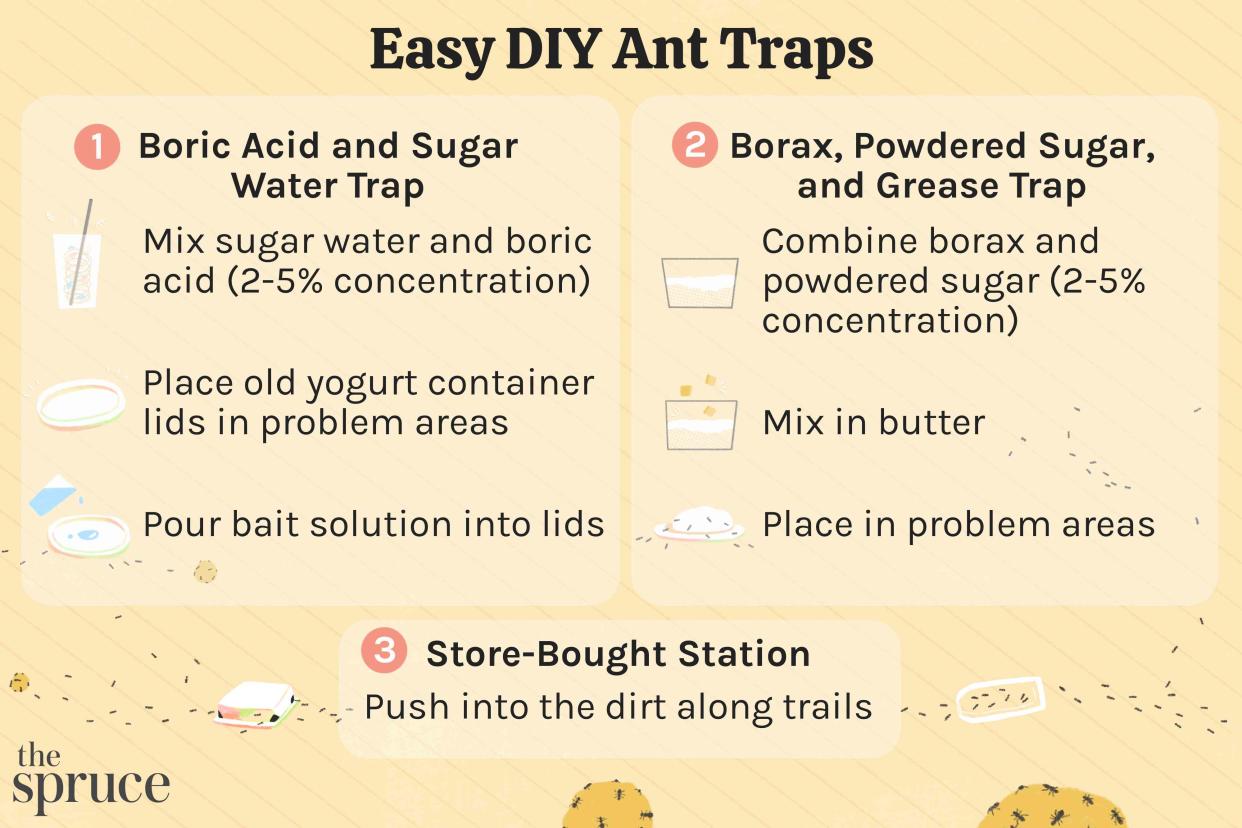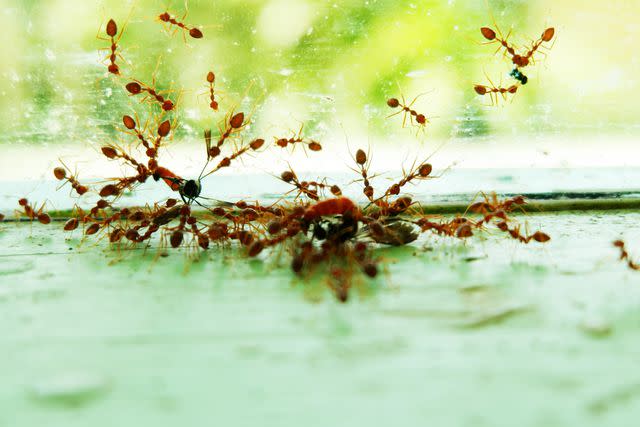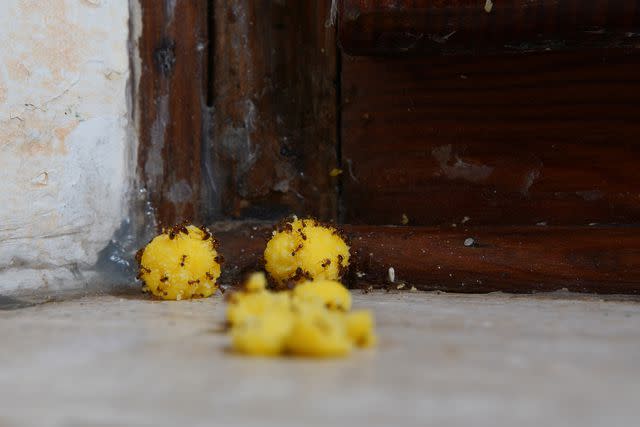3 Effective Ant Traps You Can Easily DIY, Backed by an Expert

The Spruce / Julie Bang
Reviewed by Becky Rapinchuk
Ants are a frustrating pest to deal with, as they always find a way into places they don't belong, from our pantries to our gardens. When you’re spotting ants outdoors, it’s essential to keep them outside where they belong—and if they’ve already made their way inside, you need to know how to avoid a full-blown infestation.
After all, ants vary from species to species. Handle your ant issue the wrong way, and your problem could get much worse. Here are all the best pro tips and tricks for natural ant control around your house, and they’re simple enough that you can get started right away.
Why Are Ants So Difficult to Get Rid Of?
In general, ants are difficult to get rid of because they are resilient, nest in large numbers, and are sensitive to changes in their environment. To get a little more specific (and scientific), certain types of ants are far more difficult to get rid of, and this has to do primarily with differences in their day-to-day habits and reproductive cycles.
One of the most common house ants is the odorous house ant, commonly known as the sugar ant. Sugar ants are the perfect example of a pest ant that can be especially difficult to get rid of. Many people choose to self-treat their ants without properly understanding how to identify ants or treat them according to their biology.
When sugar ants are treated with over-the-counter products or homemade sprays, it may seem like your ant issue has gone away completely, but don’t be surprised if they come back even worse than before! This happens because the sugar ant is a budding ant, whose colonies have multiple queens.
Before You Get Started
Ant control needs to be approached with forethought. Even with non-budding ants, such as pavement ants, it’s easy to simply drive them from one area of your property to another if they aren’t addressed on a root level. To do this, you’ll need to approach the job with the right mindset.
Tip
If your home needs treatment, it’s always best to call a trusted pest professional. They will perform a full inspection and ensure that the ants are properly identified and treated in a way that won’t make your issue worse in the long run.

Albertus Gilang Drigantoro Saputro/Getty Images
How to Make 3 Easy, DIY Ant Traps
Baits can work well for certain ant situations, as ants are social creatures. They're always looking out for the health and safety of the colony. When ants find a food source, they not only consume the bait themselves, but they also carry it back to the nest to share. The hope is that, eventually, the bait will reach the queen through food sharing.
Tip
Traps are going to draw ants in before killing them, so place traps in areas where you don’t mind ants congregating. Rather than putting your traps out in the open on the counter, you’re going to want to place them near ant trails in more hidden areas, like under the sink or inside a cabinet.
Materials Needed
Depending on which trap(s) you choose to make, you’ll need the following supplies:
Boric acid or borax
Sweet solution (sugar water, honey water or corn syrup water)
Plastic yogurt container lids
Powdered sugar
Animal-derived fat such as bacon grease, lard, or butter
Cleaning product in a spray bottle (something like Simple Green or a mix of dish soap and water)
Warning
These traps use boric acid or borax for as the active ingredient. While borax and boric acid are low-toxicity, children and small animals are more susceptible to poisoning than adults, so place traps in discreet areas that are difficult for little hands (and paws) to reach.
Trap #1: Boric Acid and Sugar Water Trap
This DIY ant trap is pretty simple and will be most attractive to small, sugar-loving ants such as the odorous house ant. This trap is likely ineffective in controlling other species (like the carpenter ant).
To make this trap:
Create a 2-5% boric acid solution by mixing boric acid with a sweet solution of sugar water, honey water, or corn syrup water. It’s best to start with a lower concentration, keep an eye on things, and increase the concentration as needed.
Place old yogurt container lids in hidden areas near trailing ants (behind appliances, under the sink, in the pantry, etc).
Pour your bait solution into the yogurt lid and leave it for the ants to enjoy. Adjust the concentration and refill as needed.
Trap #2: Borax, Powdered Sugar, and Grease Trap
For protein loving ant species like the pavement ant, this crumbly bait will be most appealing.
Combine borax and powdered sugar at a 2-5% concentration
Mix in enough bacon fat, lard, or butter to your powder mixture to make it crumbly
Place this bait in more hidden areas where the ants are trailing or feeding

GingerMary/Getty Images
Trap #3: Store-Bought Station
By far the simplest option, you can purchase pre-made ant bait stations from the hardware store.
While the above DIY baits use the same active ingredient as many commercial ant baits, there are certain store-bought stations that are better designed for use outside. Look for small boxes with a spike on the bottom designed for pushing into the dirt.
These station are incredibly simple to use, and typically involve putting a pre-made bait inside a small, plastic box and placing it along ant trails you’ve seen around your home.
If You're Still Spotting Ants...
Once you’ve placed your traps, you may still see ants here and there. As annoying as it can be, you’ll want to leave trailing ants alone if they’re headed for your bait so they can find it and signal their friends to come enjoy it, too.
If, however, you’re spotting an occasional wanderer on the counter or floor, these ants can be sprayed with a cleaning solution and wiped up with a cleaning rag or paper towel. Not only will this spot kill the ants you’re seeing, but it will also wipe up the pheromone trails they’re leaving behind for their pals to follow.
How to Get Rid of Ants in Your Home Using DIY Traps
Finding ants here and there is far more common than severe infestations. It’s likely you’re experiencing a mild seasonal invasion, and you may be seeing ants in specific areas, like behind the toilet or around your kitchen windowsill. In these situations, you may find yourself wanting to test your own pest control skills before contacting a pro.
DIY ant control is possible in certain situations, but you’ll need to be patient and diligent, and you’ll need to approach the problem the right way. Understand that traps alone will not solve your ant issue. In fact, they may make the problem worse before it gets better, and under some circumstances, the problem could get worse altogether.
Inspect Before Placing DIY Ant Traps
The first step of any effective pest control plan is inspection and identification. This will help you determine where to place your traps, and what steps you need to take to make sure your efforts last. Grab a high-lumen flashlight and get ready to become a pest investigator.
Where to Look Inside
When looking for ants inside, start by looking more closely in areas where you’ve already seen ants. Use your flashlight to detect ant-trailing movement in the following places:
Under sinks
Inside cabinets
Behind the toilet
Around door frames
Along windowsills
Trailing from behind or along baseboards
Where to Look Outside
Outside, you’re going to want to keep your eyes out for things like:
Ants trailing on the foundation, siding, or gutters
Any moisture-damaged wood, plant debris, or rotting stumps
Shrubs or trees touching the house
Aphids congregating on your plants
Small piles of sand or dirt along the cracks or edges of the concrete
If you have trees, shrubs, plants, or clutter right up against the house, ants can use these items like ant super highways, accessing your home discreetly from the outside. This is not ideal when you’re trying to get rid of them.
Keep plants and clutter away from your foundation, and be sure to keep your eye out for plants that have aphids on them. As aphids consume the sap of plants, they produce honeydew, which happens to be an ant’s favorite food. If you have plants that are prone to aphids, these should ideally be planted away from the house, and they should be treated with neem oil in the winter when the aphids are overwintering.
Read Next: How to Get Rid of Flying Ants
Read the original article on The Spruce.

